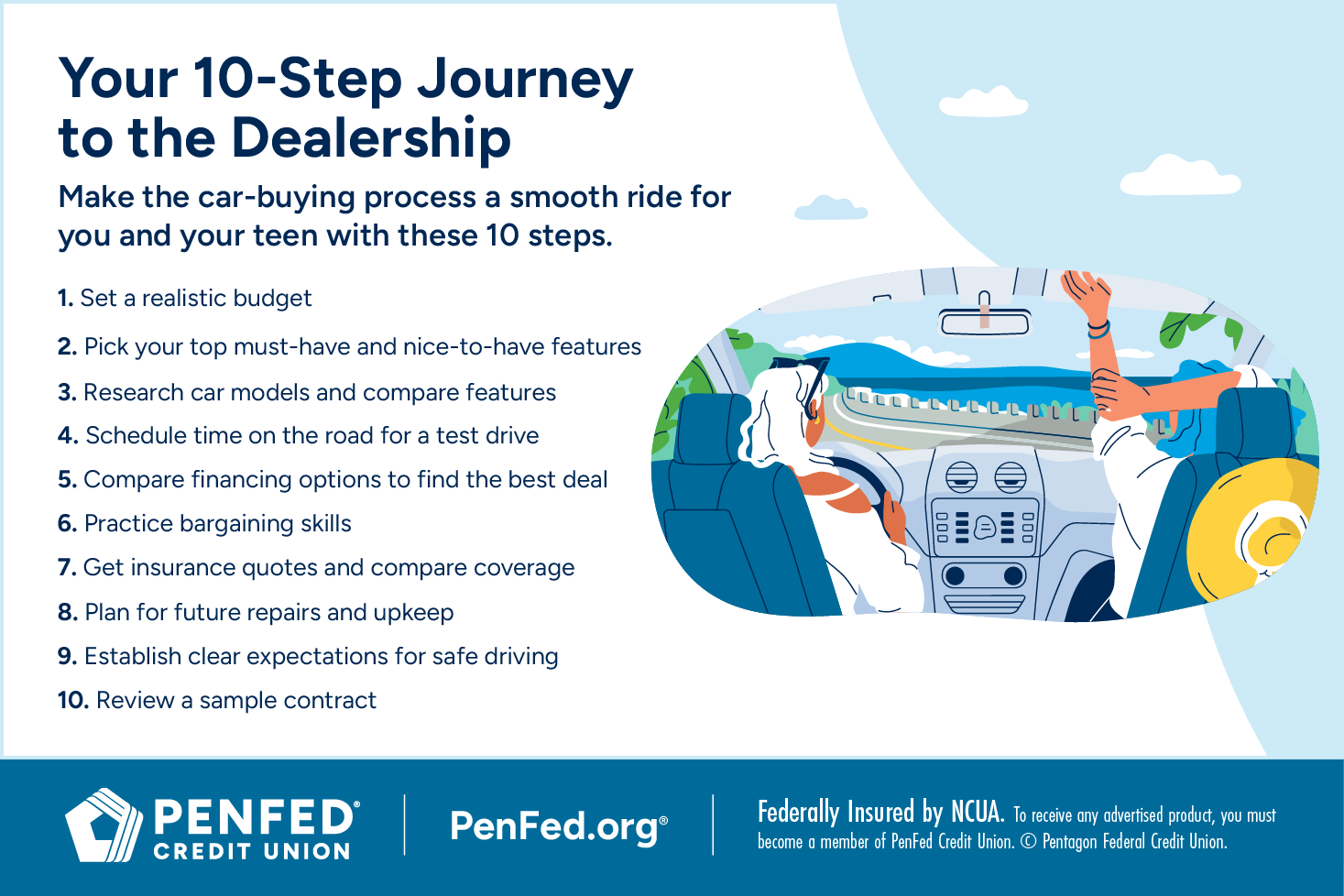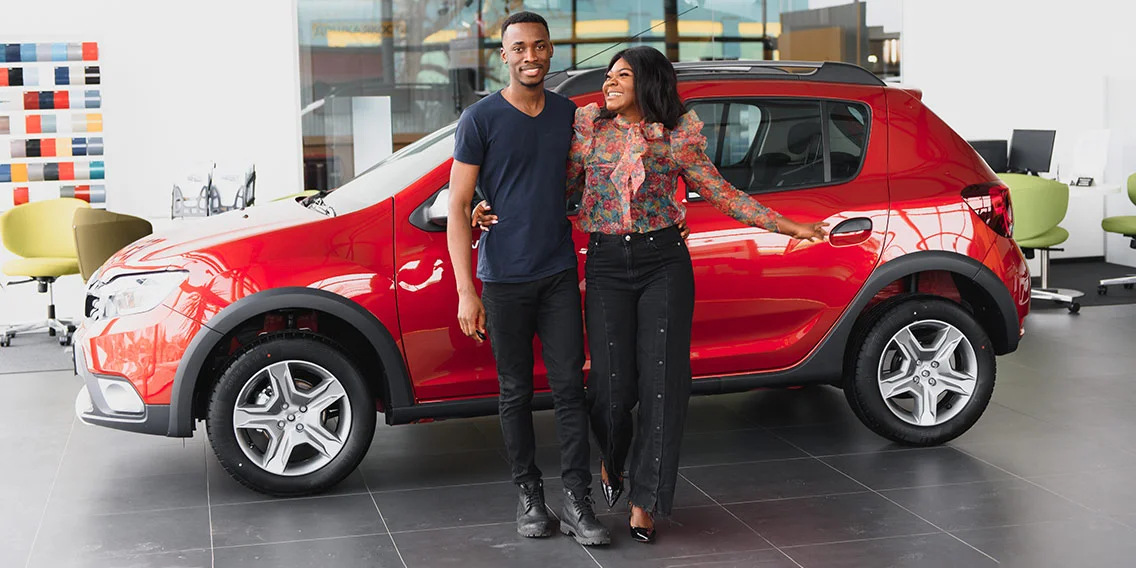AUTO
3 Golden Rules for Buying Your Teen Their First Car
What You’ll Learn: Discover how to secure the best deal for your teen’s new car.
EXPECTED READ TIME: 12 MINUTES
Think back to your first drive. Remember the pride you felt navigating your neighborhood street and the anticipation of taking trips near and far? Now, it’s your turn to help your teen experience that same excitement by choosing the right car for them.
Shiny paint jobs, flashy designs, and high-tech dashboards may capture their attention, but three fundamental rules can help you ensure your teen driver’s car is safe, reliable, and budget-friendly.
And don't forget to involve them in the process — it's just one of the many ways you can start teaching them about money.

Golden Rule 1: Prioritize Safety
This one is obvious, but it bears repeating. Prioritizing safety is non-negotiable when choosing the right car for your teen. It’s the foundation for fostering responsible driving and your peace of mind.
Start with the hard facts. Independent crash test ratings are a useful tool for uncovering those facts. Reputable organizations like the Insurance Institute for Highway Safety (IIHS) and National Highway Traffic Safety Administration (NHTSA) simulate real-world crashes and run other rigorous tests to evaluate a car’s safety performance.
The IIHS curates an annual list of top safety picks, categorized by vehicle size, while the NHTSA site features detailed explanations of its simulations along with frequently asked questions, an up-to-date list of vehicle recalls, and teen-specific safety resources. It also allows you to compare up to three vehicles, focusing on specific safety-related features like tires.
Look for five-star rides. Once you have a shortlist of potential makes and models, explore these additional safety-related variables:
Features and Equipment
The following features can provide additional peace of mind when your young adult gets behind the wheel:
Must-Have Safety Features
Three-point seat belts: These aren’t exactly cutting-edge, but they’re essential. Make sure the seatbelt fits comfortably and that your teen knows buckling up is a must.
Airbags: Side impact and curtain airbags are designed to lessen head and upper body injuries.
Electronic stability control: This safety system helps prevent skidding. It’s almost like a copilot that steps in if your teen loses control on a wet or slippery road.
Antilock braking system: With this feature, your teen can maintain steering control even when they slam the brakes. Without it, their car’s wheels would lock in such a scenario.
Automatic emergency braking: Imagine the car in front of your teen makes a sudden stop. This feature automatically applies your teen’s brakes. It uses sensors to detect imminent collisions.
The National Highway Traffic Safety Administration (NHTSA) allows you to compare up to three vehicles, focusing on specific safety-related features like tires.
Nice-to-Have Safety Features
Backup cameras: It might take some time for your teen to get used to parallel parking. This feature can help them maneuver tight spaces more easily and safely.
Blind spot detection: This feature is like an extra set of eyes for your teen. A light in their side-view mirror or an audio alert warns them of cars in hard-to-see spots.
Lane departure warning: This system nudges your teen back into their lane if they start to wander out of it.
Bluetooth: This feature lets your teen keep their hands on the wheel and eyes on the road. They can use it when they need to make a call or follow their GPS. Make sure your teen understands that texting while driving is never acceptable.
Speed limiters: Located on either the steering wheel or turn signal switch, these safety devices prevent your teen from accidentally exceeding speed limits. They’re a helpful guide for your new driver as they learn to gauge their speed.
Cruise control: This feature helps your teen stay at a consistent speed on long rides and reduces driving fatigue. While it provides some ease, your teen needs to stay alert. The system may prompt them to take hold of the steering wheel periodically.
Size Considerations
A larger automobile or SUV will typically provide more protection than a compact car if your teen is involved in an accident. But that doesn't mean you should buy them the biggest vehicle on the market. In fact, big SUVs and trucks can be challenging for new drivers to handle.
A midsize sedan often strikes the right balance between safety and maneuverability and provides adequate room for passengers and storage. Consider cars with a strong frame, designed to protect occupants in a crash. Check the IIHS and NHTSA ratings for structural information.
Visibility Tips
We’ve discussed how a car’s build can protect occupants in case of a crash, but what about avoiding crashes altogether? That’s where visibility comes in. A vehicle with clear sightlines can help your teen get through high-speed traffic with confidence.
Go for a windshield that offers a wide field of vision, well-designed side mirrors for safe highway merging, and a rear window that makes parking and reversing straightforward.
Go for a windshield that offers a wide field of vision, well-designed side mirrors for safe highway merging, and a rear window that makes parking and reversing straightforward.
Golden Rule 2: Choose Reliability
Visibility is only a piece of the puzzle. The last thing you want is your teen stranded on the side of the road. That’s why reliability should be top of mind.
You can expect reliability when buying a new car for your teenager. A fresh-from-the-factory vehicle will have virtually no miles on the odometer and be in prime mechanical condition. Plus, it will come with a manufacturer's warranty that covers certain replacements if issues arise during the first few years of ownership.
However, if you plan to purchase a pre-owned vehicle, you'll need to dig a little deeper and ask some questions. Here are some things to consider:
Mileage
Mileage is helpful in gauging reliability in the years ahead.
The average person drives around 13,476 miles annually. If maintained properly, you can expect to get 200,000 miles, or roughly 12 years, of reliable vehicle performance. So, if you're looking for a car that your teen can depend on for at least a decade, it’s a good idea to narrow your search to models with 95,000 miles or less.
Big SUVs and trucks can be challenging for new drivers to handle.
Maintenance
Maintenance records tell the true story of a car’s condition. A higher-mileage car with a history of regular upkeep is typically more reliable than a low-mileage model that’s been neglected.
During your research, look for evidence of routine oil changes, tire rotations, brake inspections, and other essential services. If possible, talk to the mechanics responsible for servicing to get a better idea of the car’s health.
Car History
A thorough review of a vehicle’s history can help you identify potential problems and avoid costly repairs down the road, as well as negotiate a fair price.
Whether buying from a dealership or an individual, ask for a copy of the car's Carfax or AutoCheck report and look for the following:
Ownership history: How many previous owners are there, and how long was the vehicle theirs?
Accident records: Are there any reported accidents, especially those involving significant damage? If yes, were there any repairs?
Maintenance records: Was the car regularly serviced?
Title history: Do you see any red flags related to the car title, such as “salvage” or “flood” titles? If yes, then the car has likely sustained major damage.
Don’t hesitate to ask the seller questions about any discrepancies or concerns you find in the report.
Break out the calculators, spreadsheets, and budget planners. While you’re at it, talk financial responsibility with your teen.
Golden Rule 3: Focus on Affordability
Affordability is arguably the most important of the golden rules.
Break out the calculators, spreadsheets, and budget planners. While you’re at it, talk financial responsibility with your teen.
Budget
Ideally, you or your teenager — or the two of you — will have enough money set aside to purchase a vehicle outright. If not, you'll want to determine how much to spend.
Keep in mind that the cost of owning a car is more than the price printed on the window sticker. When budgeting, you should account for such added costs as:
Insurance premiums
Car registration fees
Property taxes (varies by state)
Regular maintenance
One-off repairs
Fuel
If you're not sure what you can afford, run different prices, terms, interest rates, and down payments through an auto loan calculator. You’ll end up with an estimate for monthly payments. You can also contact your insurance agent to get an idea of how much it will cost to insure and register the vehicle you're thinking of buying.
What is the 20/4/10 rule for buying a car?
As you build your car sinking fund, consider the 20/4/10 rule. This widely used guideline can curb overspending. Here’s how it works:
20% down payment: This is the amount of money you pay upfront, at the dealership or to a private seller. If you’re buying a $20,000 car, a 20% down payment would be $4,000. That’s a big chunk, but a larger down payment can help you get a lower interest rate on your loan and save you money in the long run.
4-year loan term: This is the length of time it’ll take you to pay off your car loan. A shorter loan term will typically result in a lower interest rate, but higher monthly payments.
10% of your monthly income: This is the maximum amount you should spend on car expenses each month. It includes the car payment, insurance, gas, and maintenance. So, if you earn $5,000 a month, you should not go over $500.
New vs. Used Cars
Choosing between a new or used vehicle will impact your budget by thousands of dollars. In fact, the average price of a new car in 2024 was nearly $50,000, and just over $25,000 for a pre-owned vehicle.
Of course, you'll likely be looking to spend less on your teen's first car. You can find a new car in the $18,000 to $23,000 range, but it will be a base model with few bells and whistles. Or, you could opt for similarly priced used vehicles, but your teen won't get to enjoy the benefits of being the car's first owner.
It's a huge decision either way. Before making it, you should research prices, ratings, and value information from independent resources like:
Lease vs. Buy
Once the new versus used decision is out of the way, it’s time to figure out whether you want to lease or buy a vehicle.
Start by asking yourself what kind of driving experience you envision for your teen.
If you value being able to keep your kid behind the wheel of the newest makes and models (think updated security features), leasing is the way to go. Usually, you'll pay less each month than to finance a car because lease payments are based on the vehicle's depreciation rather than its purchase price.
On the other hand, if your goal is to wring maximum long-term value out of your auto investment, purchasing is best. Whether you pay cash or choose to finance, you'll eventually own the vehicle free and clear.
If you’re uncertain which option is right for you, compare the total cost of leasing versus buying.
If your goal is to wring maximum long-term value out of your auto investment, purchasing is best.
Additional Considerations
While safety, reliability, and affordability are essential, don’t overlook these additional factors:
Insurance
Your car insurance costs will dramatically go up when your teenager starts driving. According to CarInsurance.com, adding drivers between the ages of 16 and 19 to your policy increases your annual premiums by roughly $3,594, or up to 135%.
The good news? As your teen gains experience and proves they’re a safe driver, those rates will gradually drop. Until then, here’s how you can keep costs as low as possible while making sure your teen has the coverage they need:
Shop around and compare: Don’t just stick with your current insurer. Get quotes from multiple companies. Online comparison tools can help, too. Target providers with bundled discounts.
Ask about discounts: Many insurance providers offer discounts for things like good grades, driver’s education courses, and safety features. Always ask about every possible discount.
Choose a reliable car: A high-powered sports car might look cool but could stick you with high insurance premiums. Go for a car with less horsepower and more safety features.
Consider a higher deductible: A higher deductible means lower monthly premiums. It also means you’ll pay more out of pocket if you file a claim. Carefully weigh the pros and cons to figure out what’s right for you.
Track driving habits: Some insurers track young drivers’ habits using a smartphone app or device. You could qualify for a discount if your teen demonstrates safe driving over a designated period.
Negotiations
Negotiating the price of a car is a key part of the car-buying experience. However, it can be intimidating, even for adults. Hopefully, you’ve had some experience going back and forth with salespeople. If not, think of this as an opportunity to hone your car negotiation skills alongside your teen’s.
Use these tips to help your teen get better at negotiating:
Do the homework
Practice often
Be assertive
Be patient and walk away when progress is stalling
Think of this as an opportunity to hone your car negotiation skills alongside your teen’s.
Sample Scenarios
Don’t let car salespeople steer you off course. It’s important that you understand the details of any offer presented to you. We’ve come up with five negotiation examples to help prepare you and your teen for the trip to the car dealership.
The Lowball Trade-In Offer
Salesperson: We can offer you $1,500 for your trade-in.
Parent: We’ve done some research on the value of our trade-in. Considering the mileage and condition, we were expecting closer to $3,000. Can you explain how you arrived at $1,500?
Teen: We also saw similar models selling for around [insert price] online.The Limited Time Offer
Salesperson: This special offer is only good for today.
Parent: We appreciate the offer, but we need more time to consider all our options. We don’t want to rush this decision.
Teen: We’d like to think about it overnight. Can we please get the offer in writing?The Add-On Pitch
Salesperson: I recommend adding our extended warranty and paint protection packages.
Parent: We’re okay with the vehicle as is, but if we want to consider additions, we’d need some time to look at the details of both offers.
Teen: How much would each package add to monthly payments and the total cost?The Financing Game
Salesperson: We can offer you a low monthly payment, but you’ll end up with a longer loan term.
You: We’d rather have a short loan term to reduce interest. Can you show us options for a [insert number of months] loan?
Teen: What’s the difference in cost with a long- and short-term lease?The “We’re Losing Money” Tactic
Salesperson: We’re losing money on this deal. This is the lowest we can go.
Parent: We understand you’re running a business, but we also have a budget. We’re happy to make a fair offer based on our research and what we can afford.
Teen: We’ve seen similar cars going for a lower price at other dealerships.
Extended Warranties and GAP Coverage
Extended warranties and guaranteed asset protection (GAP) insurance can be valuable add-ons to your purchase.
An extended warranty lengthens the coverage period of a factory warranty, which usually expires after about ten years or 100,000 miles. You can purchase these supplemental plans through the dealer or look for a reasonably priced option from a separate provider, like a credit union. Make sure the plan doesn't include unnecessary costs for features your teen will never use.
GAP protection may make sense if you're financing a vehicle. If your teen’s car is stolen or totaled, and you owe more than its replacement value, GAP coverage kicks in and nothing comes out of your pocket. You can get GAP protection through the dealership, your lender, or an insurance company.
Getting Your Teen Involved
A first car is a rite of passage.
While you may have settled on the purchase being your responsibility, the car buying process isn’t a solo mission. It’s a chance to make an informed consumer of your teen and create memories. Here are three ways to make it a team effort:
Put together a wish list: Don’t just spring a car on your teen. Organize a date night to discuss their needs and preferences, but also emphasize the importance of safety, reliability, and affordability. Have them research crash test ratings and safety features. You can even turn it into a fun challenge, like a safety scavenger hunt. Or, get them to design their dream dashboard, focusing on placement of controls and safety-enhancing technology. Once that’s done, work together to come up with a wish list.
Attend a local car show: Car shows are a great way to see a wide range of vehicles and gather information. Let your teen ask the product specialists questions. Think of this experience as practice for the dealership.
Go for a test drive: Don’t just rely on online reviews. Take test drives together. Let your teen get a feel for different cars and share their likes and dislikes regarding comfort and visibility.
Don’t just spring a car on your teen. Organize a date night to discuss their needs and preferences.
Teaching Your Teen Money Management
The car buying process also comes with several opportunities to teach your kid about financial responsibility. Here are a few:
Discuss financing options: Even if you’re paying for the car, it’s important to break down the different ways to finance a vehicle, such as loans and leases. You’ll also want to explain how interest rates work.
Compare value: They can repeat this process when they’re ready to upgrade their car or make other major purchases.
Study purchase prices: Visit multiple dealerships to compare prices for the same make and model. Price shopping teaches your teen to be a discerning consumer.
Explore insurance costs: This can help them build skills for future insurance purchases, like life or renters.
Talk about depreciation: Explain that cars, like many assets, lose value over time but some retain theirs better than others. Consider factors like brand reputation, vehicle history, demand, and resale value.
Negotiate when the time comes: Negotiation is a lesson in budgeting and communication. Show your teen how to ask about potential discounts and role play scenarios together. When you find “the one,” let them negotiate with the salesperson (with your guidance, of course). This will set the foundation for future negotiations.
Create a maintenance plan: Explain how all investments from cars to houses to nice articles of clothing need proper maintenance to retain value — position maintenance as a non-negotiable for owning anything.
Review contracts together: Before signing any agreements, take time to read through the contract terms with your teen. Make note of payment schedules and warranty details and draw their attention to the fine print. This is great practice for future purchases that involve legally binding documents.
Common Questions About First-Time Car Purchases
If you or your teen are still unclear about certain aspects of the car-buying process, these questions can help.
What credit score do you need for a first-time car buyer?
Credit score requirements vary between dealerships and lenders. However, about 71% of cars financed in 2024 went to borrowers with a credit score of 661 or higher.
How much money should a 16-year-old spend on a car?
There is no set amount. Consider what’s realistic for your family, factor in safety ratings, and map out maintenance to determine the best investment for your 16-year-old.
The Takeaway
No amount of planning or preparation will take away the butterflies you’ll feel when you hand over the keys and watch your child drive off unaccompanied, but sticking to the golden rules will ensure they’re well prepared for the road ahead.
Remember, this is their first car, not their last.
Find your perfect ride with PenFed's Car Buying Service
Quickly qualify for a PenFed auto loan and begin car shopping today.




